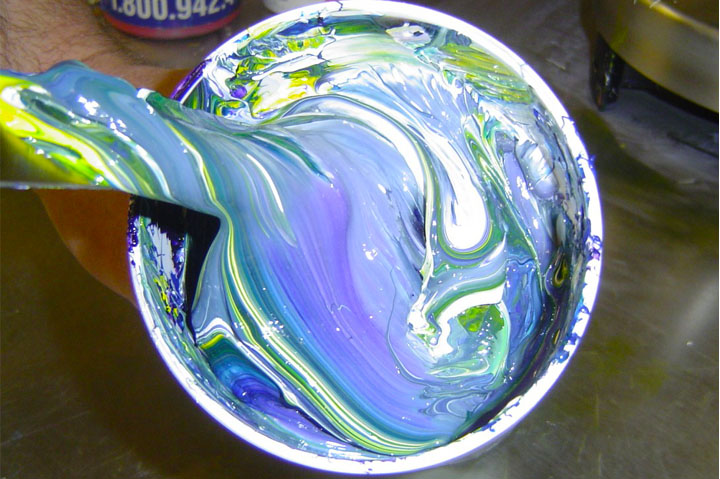July 03, 2023
Decorator’s View: Speak the Language of Screen Printing
Understanding common decorating terms will help distributors avoid confusion and misunderstandings when ordering logoed apparel.
The easiest way to avoid mistakes and confusion when ordering decorated apparel and products is to speak the language of the decorators. Here are some tips on talking the talk.
Decorator’s View is a regular column written by screen printers, embroiderers and other apparel-decorating experts, sharing their best business-building, marketing and technical tips to help the promo industry elevate logoed apparel.
Screen Printing

Most screen printers print with easy-to-use and very durable plastisol inks. (Photo courtesy of Graphic Elephants)
Screen printers will likely be the most common decorator you’ll deal with on a contract basis. Most screen printers live in a world of one-, two- and three-color printing. You can certainly order more colors in your graphic, but costs go up per color in both setup and price per shirt.
- Substrates: One of the best qualities of screen printing is that most fabrics can be used, from 100% cotton to tri-blends to 100% polyester, and all the variations in between. Special fabric such as water-repellant nylon or wicking fabrics may require additives to the ink, but all can be decorated.
- Plastisol vs. Water-Based: Most screen printers still prefer plastisol inks. It’s very forgiving for the decorator, won’t dry in their screens and, when properly cured, is a permanent decoration. Some screen printers work with water-based inks, as well, and both kinds of ink produce a similar result. Plastisol can be thinned with a curable reducer to have the same hand (feel) as water-based.
- Screen or Setup Charges: Screen printers will charge a screen or setup charge per screen, which translates to per color in the design. You’re paying for the use of the screen and its preparation, not for the actual cost of the screen.
- Spot Color: Spot-color printing is what the vast majority of screen printers do: a blue sky, a yellow sun, black outline and copy on the shirt.
- Underbase: For maximum opacity and brightness of an image on a colored shirt, a screen printer will print an underbase first. The underbase is then “flashed” for about 15 seconds under a flash heating unit until it’s dry to the touch. The colors are printed on the underbase wet on wet, one color on top of the next. The underbase is only gelled, not cured. If an underbase is cured completely with the flash step, the colors on top will wash out. This underbase is commonly white but can be gray or other colors.
- Simulated Process: Simulated process is what screen printers do to make a photorealistic image on a shirt. A process print (CMYK) is simulated using solid plastisol inks and printing in halftone dots to blend colors. Screen printers will commonly print on colored fabric, so a white underbase is laid down, then opaque plastisol inks – scarlet red, lemon yellow, etc. – are printed on top to simulate the CMYK process. Not all screen printers have the technical expertise for this type of decoration.
Direct-to-Garment
Direct-to-garment (DTG) printing is an inkjet process with the garment being directly printed. On a colored shirt, the printer will first lay down a white underbase, and then full-color printing on top.
If the garment from your decorator feels stiff around the image, they’ve used too much pretreat solution in the process. This is the most common error DTG decorators make.
- Substrates: The best fabric to use with a DTG printer is ringspun cotton. Ringspun uses thinner threads than a typical cotton garment, and therefore gives a tighter weave and smoother surface. Unlike screen printing, the quality of the shirt dictates the quality of the print. Second-best are typical cotton shirts, and then high-cotton-content blends. Other garments can be printed, but additional steps, heavier laydown of pretreatment and heavier laydown of white ink are required to achieve an acceptable print.
- Pretreatment: Pretreat solution is a saline-based compound that’s applied to a garment then dried. When DTG water-based ink is applied, the pretreat causes the ink to begin curing on top of the shirt. This allows for a bright finished image. Without pretreat solution, the ink will absorb into the garment and disappear. With white garments, you can pretreat if you want a crisper image, but that’s a personal preference. With colored shirts using a white underbase, the pretreatment step is required. If the garment from your decorator feels stiff around the image, they’ve used too much pretreat solution in the process. This is the most common error DTG decorators make.
Direct-to-Film
Direct-to-film (DTF) printing is the latest development in garment decorating. Printing transfers can be accomplished using a DTG printer or a standalone DTF printer.
- Substrates: You can literally print on almost any fabric using a DTF transfer. Heat press temperatures to apply these transfers can be anywhere from 275°F to 325°F, so there’s no damage to heat-sensitive materials such as polyester. When properly applied, DTF transfers have surprisingly excellent washability. Many promotional products distributors will buy the transfers from a supplier and apply the decoration themselves using a heat press.
Terry Combs is a 40-plus-year veteran of the garment-printing industry and has managed production shops large and small across the United States. He has written hundreds of management and technical articles for garment decorating publications and spoken at industry events worldwide.
